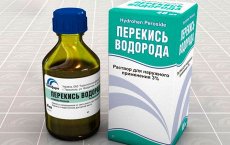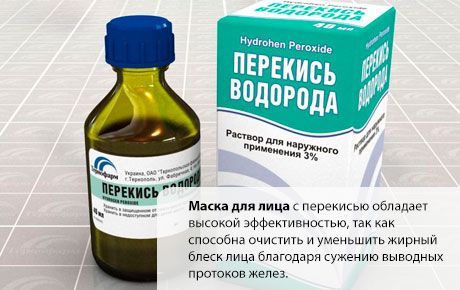Medical expert of the article
New publications
Peroxide mask
Last reviewed: 06.07.2025

All iLive content is medically reviewed or fact checked to ensure as much factual accuracy as possible.
We have strict sourcing guidelines and only link to reputable media sites, academic research institutions and, whenever possible, medically peer reviewed studies. Note that the numbers in parentheses ([1], [2], etc.) are clickable links to these studies.
If you feel that any of our content is inaccurate, out-of-date, or otherwise questionable, please select it and press Ctrl + Enter.

In cosmetology, you can often find masks used for various purposes. They can be either a medical procedure to combat rashes or "rejuvenating". A mask with peroxide is considered an effective way to improve the condition of the skin, give it a healthy appearance and eliminate excess sebum secretion. In addition, with the help of regular cleaning, contaminated areas such as pimples and pustules are sanitized and healed faster.
All recipes based on hydrogen peroxide must use a 3% solution. The mask should not be applied to the area around the eyes, lips, or mucous membranes.
Face mask with peroxide
A face mask with peroxide is widely used as a makeup remover and for medicinal purposes. Of course, for simple cleansing you can use peroxide without additional ingredients, but in the case of a mask, it is recommended to follow some rules for preparing and using the product. The main point in using peroxide is caution, since it is a powerful component of any cosmetic product, so it can not only cleanse and degrease the surface of the skin, but also harm healthy cells.
A face mask with peroxide is highly effective, as it can cleanse and reduce oily shine on the face by narrowing the glands' excretory ducts. Following the rules for using the mask will prevent burns and allergic reactions on the skin. To achieve the desired goal and avoid side effects and complications, it is necessary to strictly control the amount of peroxide used for the mask, as well as the duration of its use.
Benefits of peroxide for facial skin
In order for any cosmetic product to be useful for a certain skin type, it is necessary to first familiarize yourself with its composition and the effect of each component on skin cells. Thus, considering the structure of hydrogen peroxide, we can distinguish its two components - water and oxygen.
The benefit of peroxide for the skin is that oxygen, getting to the surface, reacts with the existing products of bacterial infection and other contaminants. As a result, they rise to the surface of the skin, where they are removed with the help of water. Peroxide, thanks to its components, simultaneously cleanses the foci of infection and removes them from the skin.
In the mask, the benefits of peroxide for the skin are the ability to disinfect the skin surface, cleanse clogged pores and rashes, have an anti-inflammatory effect, and also lighten the skin and fight acne scars. Thus, the intensity and prevalence of irritation, inflammatory reaction decreases, and the skin is cleansed of acne, rashes and pigmented areas after acne.
Mask with sponge and hydrogen peroxide
A mask with sponge and hydrogen peroxide is used as a remedy for acne and pigment spots and scars after cured rashes. The mask should be used during the period of the year when solar radiation activity is minimal to avoid the appearance of additional pigmentation.
The properties of peroxide are already known, but as for the sponge, it is necessary to highlight the exfoliating effect, improving local blood supply to cells and the restorative effect.
To prepare the mask, you need a powdered sponge and hydrogen peroxide. The proportion of ingredients should be such that a thick mass is formed. Then, over the course of a minute, it begins to increase slightly in volume with the formation of bubbles (foam).
The mask with sponge and hydrogen peroxide is applied to the affected areas of the face, gradually rubbing into the thickness of the skin. The healing mass should completely cover the area without gaps. Over the next 20 minutes, the mask dries. After a certain period of time, it must be removed with water at a comfortable temperature.

After using this product, the skin may acquire a red tint and even peel, a slight irritation may appear, so it is recommended to use talc to soothe the skin. Hyperemic skin can persist for up to 2 days, so the mask should be used no more than 2 times a week.
In some cases, the skin's reaction to peroxide can last up to a week, so the next procedure should not be performed until the skin has recovered. The effect is observed after the first use, but to consolidate it, it is necessary to apply the mask 5 times, after which a break of about 4 months is required.
Mask with yeast and hydrogen peroxide
Yeast is successfully used not only for the preparation of bakery products and cakes, but also for skin health. The healing properties of yeast are provided by the presence of essential vitamins for the skin, such as group B and vitamin PP, and various enzymes, proteins and minerals.
A mask with yeast and hydrogen peroxide can make the skin velvety, soft, with an even healthy tone and pleasant to the touch. By reducing the diameter of the gland's excretory duct, the skin gets rid of oily shine. This mask is perfect for normal and oily skin types. However, in addition to using it for the face, you can apply the mask to the neck or hands.
To prepare the mask mass, take 15 g of yeast (fresh) and 5 ml of peroxide (3%). Before mixing them, crush the yeast in a mortar, and then add the peroxide. Mix until a thick, homogeneous mass is formed. Its consistency should resemble sour cream.
A mask with yeast and hydrogen peroxide should be applied to the skin and kept for up to 20 minutes. It is advisable not to talk or laugh during the procedure to relax the facial muscles. After the time has elapsed, the mask should be removed with water at a comfortable temperature. After this, it is recommended to moisturize dry skin, and then wash with chamomile decoction to reduce irritation and inflammation.
Oatmeal and Hydrogen Peroxide Mask
Oatmeal is considered to be a concentration of a huge number of microelements and vitamins, so it is used not only to obtain an energy supply for the day, but also in cosmetics.
Not only oatmeal, but even its decoction is recommended for washing, previously diluted with water. A mask with oatmeal and hydrogen peroxide is used to get rid of acne, inflamed areas of the skin and cleanse clogged pores.
There are several recipes for this mask. The first one involves using crushed oatmeal flakes with peroxide for oily and normal skin types. The resulting mass should be applied to the affected areas of the skin for no more than 5 minutes. During this time, it is advisable to lightly massage the areas with the applied product, trying to rub it into the deeper layers and cleanse the pores.
Special warnings concern the properties of peroxide, because a mask with oatmeal and hydrogen peroxide can cause a skin burn if the proportions are not observed during preparation, as well as if the time it is left on the face is extended.
The second recipe involves using soda, peroxide and oatmeal. For cooking, you will need 15 g of each ingredient. After combining them, you need to evaluate the consistency of the mass; if it has not become thick, then you can add a little water.
The prepared mask should be applied to areas of skin with rashes and acne "dots" and left for 5 minutes, periodically massaging. After the time has elapsed, the product should be removed with water.
Whitening masks with hydrogen peroxide
Whitening masks with hydrogen peroxide are universal and suitable for all skin types. The recipes for preparation are simple, so you can use them at home. There is far from one way to prepare such masks, but you should focus on the most common ones.
For the mask you need white clay, zinc oxide and hydrogen peroxide. The volume of each ingredient is as follows: white clay - 40 g, zinc oxide - 10 g. After combining them, you need to take 5 g of this mixture and dilute it with peroxide. In the end, you should get a thick mass that is used as a mask for 15 minutes.
Whitening masks with oxygen peroxide have not only a lightening effect, but also a cleansing and drying effect. Another recipe is based on the use of one egg white and peroxide. For one egg white whipped into foam, you need 5 g of peroxide. Some recipes suggest adding an additional 50 g of cottage cheese. The resulting mixture can be used for application not only to the face, but also to the neck area for several minutes. After the time has elapsed, the mask should be removed with water.
Mask with clay and hydrogen peroxide
A mask with clay and hydrogen peroxide has a lot of positive qualities, with the help of which the skin becomes elastic, regenerates and cleanses faster. White clay is widely used for cosmetics. It is included in masks for deep cleansing and getting rid of acne, helps to get rid of microbial contamination and active regeneration, and also saturates the skin with microelements.
Clay is especially often used for sensitive skin types that are prone to flaking, dry skin with age-related changes.
A mask with clay and hydrogen peroxide is prepared using clay, magnesia carbonate, purified talc, borax and peroxide. The amount required is 5 g of clay, 4 g of magnesia and borax, and 3 g of talc. All ingredients are mixed and diluted with peroxide until a thick mass is formed.
The resulting mixture should be applied to the skin of the face and neck and wait for about 10 minutes. To remove it, you can use a cotton swab and water. For greater effectiveness, it is recommended to use herbal decoctions for washing.
Reviews of masks with hydrogen peroxide
Reviews of masks with hydrogen peroxide include more positive reviews than negative ones. Dissatisfaction with these masks was observed in people who did not follow the rules for its use. In addition, after using masks with peroxide, skin care is necessary, since it is quite an aggressive agent for affecting cells.
In addition, do not forget about the individual reaction to the components of the mask, among which it is necessary to highlight allergic reactions from the skin. To avoid this, it is recommended to conduct a test on the front surface of the forearm before using the mask on the face. You should take a small amount of the prepared product and apply it to the wrist. If after 10-20 minutes there is no reaction, then you can apply it to other areas of the skin.
Positive reviews of masks with hydrogen peroxide account for almost 85% of all reviews. Such masks help get rid of rashes, cleanse pores, help smooth out scar tissue after acne, and also whiten the skin. In addition, a mask with peroxide allows you to forget about skin pigmentation, provided that it is used correctly.


 [
[